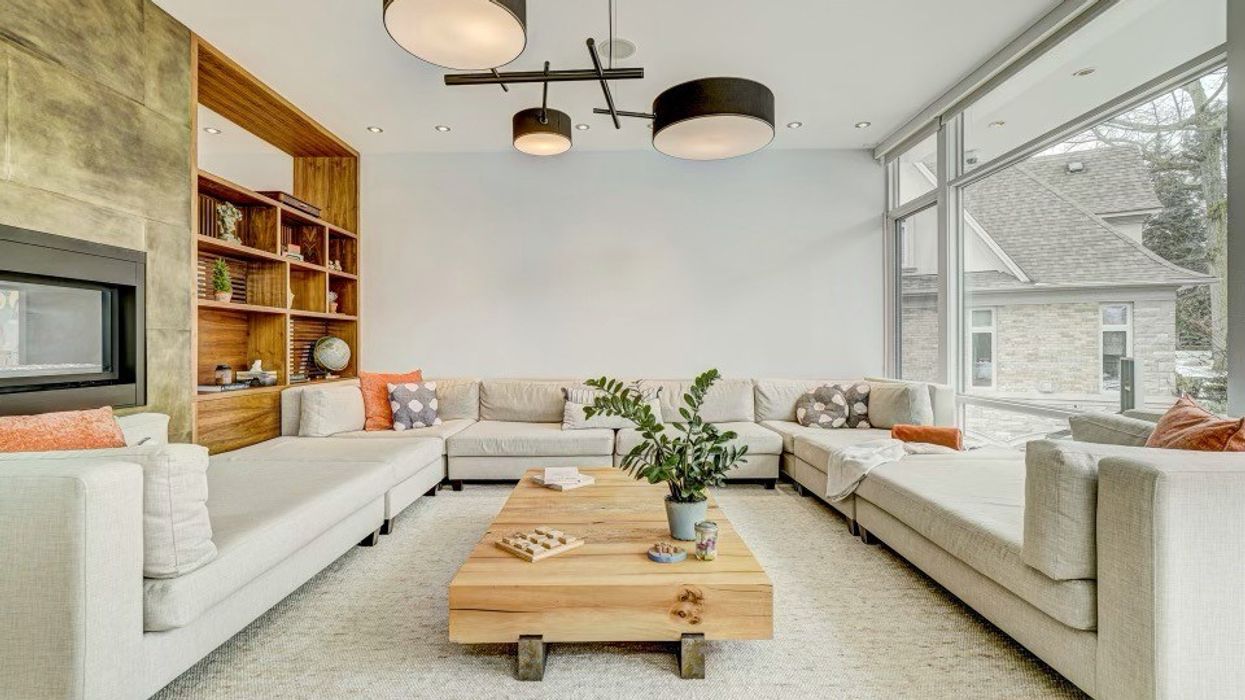It’s hard to slam a door in someone’s face when you have barely any doors. All you can do, really, is stomp over there angrily and face the other way.
Not that Olena and her husband have the luxury of having a fight — the couple have a 2-year-old son in their cozy 540-square-foot condo near Dufferin and Queen. The toddler hears everything.
“We do argue, like everyone else, but without performances,” she says. “With the baby, it's been very challenging — you have to be quiet after 9 p.m. and there's no room for that. No TV, no loud music, no late friends, not even phone calls.”
Talking, toys, tantrums
The tight space has a few minor conveniences — a toddler in a small space is easy to supervise, there’s less space to clean — but Olena points out a handful of drawbacks: late calls are taken in the stairwell, toys easily fill up their living space, there’s nowhere to hide from a tantrum, and private personal space is basically non-existent. And the miniature human is only going to get bigger.
Unsurprisingly, her small family spills out into the constellation of public spaces around their neighbourhood — parks and playgrounds, public libraries, the AGO and ROM. Anywhere there are craft materials or books available — that keeps Olena’s condo free of clutter.
Otherwise, Olena and her husband cope by sharing childcare and chores, donating toys and clothes the instant they are no longer needed, and scheduled breaks on weekends.
“The weekend child care really works for us, she usually comes and takes him away for the whole daytime, so we can catch a breath.”
Overall, her family is managing the routine, Olena says, but “being locked in a small condo is rather negative.”
“We just believe it's a temporary situation for us, otherwise we both would go crazy,” she says. “We, as an older generation, still need some physical private space, as it's a matter of habit, and open-concept condos make me seek privacy.
“So, for me, we don’t necessarily need to have a huge house — but a separate room for each family member, even if it's a tiny one.”
Modern love
When we think modern relationship challenges, our mind jumps to dating apps and text response times and the ever-shifting etiquette and boundaries in an online world. We might not necessarily think of the real estate market.

But Toronto therapist and marriage counsellor Tammy Laber sympathizes with those who try to manage the expansive expectations of love — and the tedium of daily life — in roughly 500 square feet.
“Once upon a time, we had houses where one member of the couple might go to the garage or workshop and do some work, and one member of the couple might go out to the garden and do some work, or they had sewing rooms or dens,” she says.
“With tiny living quarters, not so much.”
Laber points out that space is an important part of every person’s identity and well-being, two parts that obviously contribute to the relationship whole: “It’s psychic space, not just physical space, but the two are linked.
“We need time in our own skin, time away from everyone, not just our partner,” she says. “Everybody needs a certain amount of alone time to be with their own thoughts, and to think things through, without intrusion from others.”
Laber notes that introverts have different needs from extroverts — “Some people need a lot more space than others” — but that the illusion of space can be created with partitions, rules, schedules and communication.
In an open-concept condo, screens, drapes or other partitions can make one area feel more secluded than others — and they’re easy to shift around. Much like the principle behind cubicles, Laber says. Condos with several rooms with doors, no matter how tiny the room, also get the job done.
Naked Club
Schedules also help, Laber says. If one part of a couple is more social than the other — an extrovert vs. introvert pairing — that person can join social clubs, such as book clubs or recreational sports, while the other partner can stay home and have an evening to themselves. And then, of course, also schedule time for the Naked Club.
“My biggest suggestion for couples in general is planning date nights and when you have windows of opportunity to be intimate,” she says. “People take it for granted, that it will happen. But they don’t take for granted that going to the gym will happen. Why do they take for granted that spending an hour naked with their partner, fully focused on their partner and fully present, is going to happen?”
Communication, meanwhile, helps partners decode each other and understand when someone wants space, or closeness. A cloying, needy partner is just as alienating as a distant partner — so just verbalize, she says. Ask for what you need.
“It’s not just scheduling,” Laber says. “It’s openly discussing your needs. How do we ask for space in a way that isn’t going to offend anyone?”
When the going gets tough
All this communication is great… when it’s positive and productive. But when that communication turns negative, a big fight in a small space can get explosive — too many emotions sparking off one another, not enough room to remain unscathed. Laber says it’s easier to calm down if you take a break.
“When we start getting angry with each other, we get filled with two hormones that affect our brain functioning — one is cortisol and one is adrenalin,” she says. “When you are flooded with adrenalin and cortisol, the prefrontal cortex — which is executive functioning, makes good decisions, forms long-term plans, weighs pros and cons — practically goes offline.
“When it goes offline, you’re now using the emotional parts of you — the amygdala, the fear centre — that’s taking over and making your decisions, and you’re not thinking in your best brain.”
Taking a break will enable you to calm down, not to avoid, Laber emphasizes.
It's not them, it's you
And lastly — although certainly not least — is remembering that your partner is still the same person as that hot date you first connected with. Now that you’re sharing daily life, however, your perception of them is no longer fuelled by excitement, novelty and desire.
“During the first few months, you’re getting a hormonal assist,” Laber says. “It’s called limerence — the state of being newly in love — and it can last for a couple of years, but it wears off. It wears off for everybody.
“So when it wears off, you don’t give your partner the benefit of the doubt like you used to, and little habits annoy you more.”
In other words, now it’s work. “You have to switch to what I call ‘conscious loving,’” Laber says, “instead of unconscious, hormone-fuelled loving.”
This is part 1 in our series, Love In Small Spaces — watch for the story of our newlywed couple, who live in a small condo in their matching onesies, next Monday, June 12.
Have you found bliss and balance in a small space? How do you stay sane and in love? Condo or apartment dwellers, and couples living in that GTA shoebox, we want to hear from you. Your story may be featured in our ongoing series. Email info@storeys.com, tweet us @torontostoreys, or connect with us on our Facebook page.





















